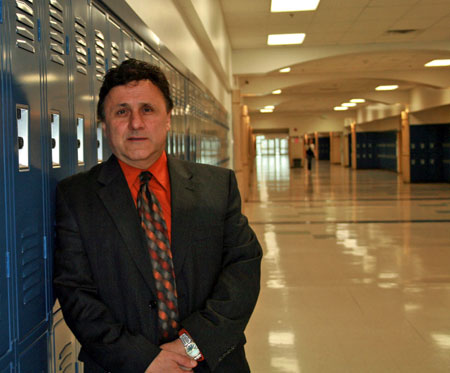Columbine Principal Leads Charge To Rebuild
Comments (15)
LISTEN TO CLIPS FROM THE INTERVIEW

Columbine High School Principal Frank DeAngelis narrowly escaped being killed
during the shooting. (photo by Tina Mather)
Interview excerpts

Columbine High School Principal Frank DeAngelis narrowly escaped being killed
during the shooting. (photo by Tina Mather)
Interview excerpts
DeAngelis talks about need for awareness.
DeAngelis talks about the common bond of those who experienced the tragedy.
DeAngelis talks about students' self-reporting concerns.
DeAngelis talks about the question of what caused it.
Monday was the 10th anniversary of the shooting at Columbine High School in Colorado. Staff reporter Tina Mather traveled to Columbine and spoke with the school's principal, the sheriff department's chief investigator and a student survivor and his family. Her interviews with the investigator and family ran Tuesday and Wednesday. On Thursday Tina will have a behind-the-scenes look at "April Showers," the movie based on the shooting that opens this Friday.
It was lunchtime, just after 11 a.m. on Tuesday, April 20.
Columbine High School Principal Frank DeAngelis was in his office when he was alerted of gunfire outside. He ran out into the hallway by the east doors to find out was happening. At that moment, the gunmen, who had just finished killing students outside, entered the building from the west doors.
There they were: gunmen on one side of the long hallway coming towards him, DeAngelis on the other.
In an instant, he heard the sounds of sprays of bullets and glass breaking directly behind him. The glass trophy case nearby literally exploded because of the shots around him.
Then he heard students in a side hallway coming in from a gym class, completely unaware, walking closer to the gunfire.
At that moment he had a choice: retreat, or run toward the gunfire into the side hallway to save the students.
He ran and ushered the students back into the gym. The door was locked. He had a ring full of keys: the first one fit.
After locking the students safely in a storage room, he went outside to face the next minutes, hours, and days that would unfold as the world watched on live television.
In the next hours, he would find out that 12 of his students, and teacher Dave Sanders, a close friend for over two decades, had been killed. More than 20 students were injured.
And he soon felt an enormous amount of guilt that it wasn't him.
"Why were the 12 killed? Why was Mr. Sanders killed?" said DeAngelis. "It could have very easily been me that day ... I don't have those answers."
In the 10 years since the tragedy, Columbine High School has been the central focus of a community struggling to rebuild. Frank DeAngelis -- who has been at Columbine High School for 30 years and principal for the past 13 -- was at the forefront, trying to bring the school back in the midst of lawsuits, the demand for answers, and unanswerable questions.
Aftermath
He didn't have answers. There was no time for him to grieve. But Frank DeAngelis would be called on to address the public as early as the next morning.
And for the next year, the expectation was for the principal of Columbine High School to be the strength of the community. He was riddled with guilt. Whether it involved taking care of community members, staff members, or students, he was inundated with requests.
A few days after the tragedy, DeAngelis received a phone call from a family friend, a doctor who was a Vietnam veteran.
"You need to address taking care of yourself. You'll find every reason not to," he told DeAngelis. "If you can't take care of yourself, you can't take care of anyone else."
DeAngelis started counseling shortly after.
"I had so many people looking to me for answers," he said. "I felt that if I was not strong then I would be letting them down."
"If someone would have asked me prior to the tragedy, given me the scenario and asked, 'How would you deal with that?' I would have said I couldn't. But all of a sudden it just happened."
It would be over a year before he could reflect and grieve.
But the questions and guilt remained. DeAngelis recalled a conversation he had with his priest shortly after the tragedy.
"We don't have those answers," said his priest, "But I can assure you that you were saved on that day for a reason. Now you need to go forth and bring that school back to where it needs to be, wherever that may lead you."
"That was a huge challenge for me," said DeAngelis.
A Community Grieves
Grief took its course in Columbine. Shock. Denial. Anger.
Not just the community, but the nation demanded answers and someone to take responsibility -- and the murderers weren't around to blame.
Stories swirled around that bullying had driven the killers to the massacre. Blamed was placed on the school for allowing bullying to take place.
"I'm not saying that bullying did not occur here. But there had to be more inside [of them] that caused this, because there are kids throughout our country, throughout high school that are bullied," DeAngelis said. "I was involved in a bullying situation where I was bullied, but I never thought about going and killing classmates. So there had to be more inside these two, the makeup of these two that allowed them to do this."
DeAngelis was named in eight lawsuits; other staff members were also named in lawsuits that alleged they knew of the two students' behaviors and could have taken action to prevent it.
"I was afraid that if I allowed the negativity to get me down or kick me down, that I may never be able to get back up," he said.
"All of a sudden you start reading these stories and you start questioning yourself, and you start thinking, 'Am I this person that they're describing in these newspapers or that they're talking about on the TV stations?'
"I could never tell a parent that had their child murdered, or a student who was injured, 'I know how you feel,' because I do not," said DeAngelis. "I try to empathize with them and sympathize with them, but also understanding why there was so much anger towards me."
For DeAngelis, post traumatic stress disorder set in. He didn't know it was PTSD; he couldn't figure out what was wrong. He had aches and pains. He was distracted. Something wasn't right.
There were days he questioned if he could go on as principal.
"I was thinking, 'Gosh, what is wrong with me? Why am I feeling like this?'" he said. "The mental stress transferred to physical symptoms and I was uncertain what was going on."
Finding Strength
As the school and community struggled to cope, he would find the best way to lead was by sharing his own struggles.
"They'll come up to me and say, 'Gosh, you're so strong, how did you get through it?' and I'll say, 'You don't see the other side.' So I try to share some of my stories, you know, 'I'm struggling, my concentration level is not where it needs to be,'" he said. "[They would say,] it's the same with me ... We're alright, but what we're going through is something that really is occurring."
DeAngelis said he had to decide where he stood with himself, with other people, and with God.
"It got to the point in my life where I thought, I know what kind of a person I am, I care about kids. That was the one thing that hurt me the most, when I was accused of not caring about kids, or not being in touch with the kids."
"I have a lot of faults," he said, "but one of my strengths is the rapport I have with the kids. That's one of the reasons I got into education, that's why I'm still here 10 years after the tragedy and spent 30 years at Columbine. And so, it got to the point when I looked in the mirror and looked deep down inside my heart, I came to the conclusion that no one is going to judge me on the face of this earth. My judgment's going to come after. And it was there, at that point in my life, when I made that decision, that I was able to move forward. That's how my faith played an important role for me. And I live by that."
We Are ... Columbine
A few weeks ago, a student from the class of '99 came by the school to say hi to DeAngelis.
"She just had a baby, she's married, and we were talking and laughing and she said, 'Mr. D., I just celebrated my 28th birthday.' And that made me realize 10 years had passed," he said.
It's Columbine. Things have changed since that day 10 years ago.
DeAngelis is one of only 33 teachers and support staff that remain at the school out of approximately 150 staff that were employed at the time of the shooting.
For an outsider, arriving at Columbine High School today is similar to visiting any location marked by tragedy. It is eerily familiar; the building so recognizable with its turquoise windows if only because of the media loop ten years earlier.
Although security has changed, there are no metal detectors to go through, no armed guards blocking the entrance. The school has not been made a prison by the tragedy. There's a brand new library and a new cafeteria with a ceiling that extends into where the second floor library used to be located. Murals of Aspen trees reaching to the sky in memory of the victims hang from the atrium ceiling.
Rebuilding has been tough. But DeAngelis has always preached the message of "the Columbine family," and he continues to make sure everyone feels he or she is part of it. "We are ... Columbine!" is the school's rally chant. He had led that spirit cry at a pre-prom assembly the weekend before the shootings; he will undoubtedly lead it on Monday's 10th anniversary observance at the Columbine memorial behind the school.
"If there was not a strong foundation in place, if the foundation was made of sand, then we wouldn't be where we are," he said.
For Frank DeAngelis, the name Columbine is not a generic term for a mass shooting. It's been his home for 30 years; it is his family. "We'll never forget the 13 who died, the kids who were injured, and all the people that were so deeply impacted. But there were other things that occurred at Columbine that were positive," he said.
Columbine High School is healing. In Colorado, people continue to recognize Columbine as a good school with an outstanding academic program where graduation rates are over 90 percent.
The current freshman class was in Kindergarten the day of the tragedy. DeAngelis feels a responsibility for them; most of them were in Columbine-area schools that day. He intends to see that class through to graduation.
"I just feel that in my heart, I owe it to them," he said. "Because I was in charge that day and it's something that I'll have to live with for the rest of my life."



